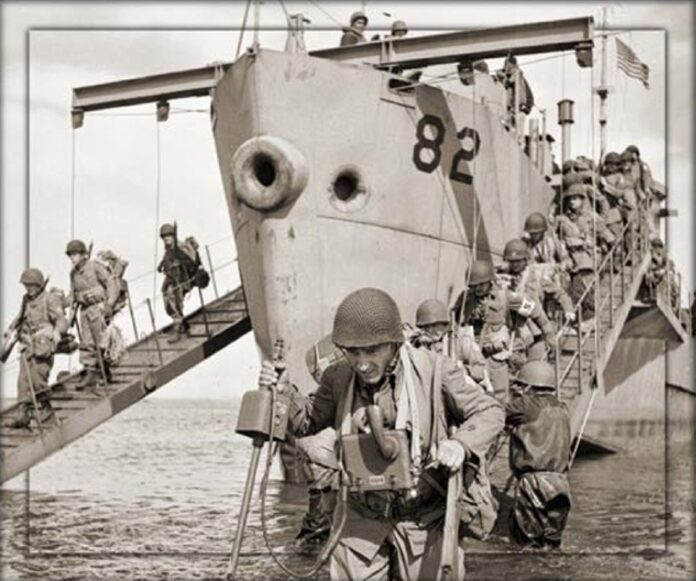
On Friday, Anchorage will be the center of the world’s attention as President Donald Trump and Russian President Vladimir Putin meet at Joint Base Elmendorf-Richardson, a summit that could recalibrate US–Russia relations for years to come.
SUVs will lumber through the streets, security perimeters will stretch for blocks, and the world’s media will be watching Alaska, as diplomats, possibly including Secretary of State Marco Rubio, Treasury Secretary Scott Bessent, and Special Envoy Steve Witkoff.
You may even spot Sean Hannity walking in downtown Anchorage, as Americans for Prosperity’s Regina Wright did on Thursday.

It’s not the first time Aug. 15 has carried historic weight for Alaskans. Eighty years ago to the day, the Last Frontier was listening to a very different kind of news: The end of the deadliest war in human history.
On Aug. 15, 1945, radios across the territory crackled with the voice of President Harry S. Truman announcing Japan’s surrender.
In Anchorage, church bells rang, sirens wailed, and spontaneous parades filled the streets.
Cannery whistles blew in coastal towns, children banged pots and pans, and service members in uniform embraced strangers. For Alaskans — some of whom had lived under the shadow of war since Japanese forces occupied Attu and Kiska in 1942 — it was a day of relief, joy, and remembrance for the thousands who never came home.
Alaska’s wartime role had been outsized for such a sparsely populated place. The Aleutian campaign was the only instance of foreign occupation of US soil in the 20th Century.
The Alaska Territorial Guard, made up largely of Alaska Natives, had patrolled thousands of miles of coastline. The construction of the Alaska Highway and vast military airfields transformed the territory into a critical strategic link between North America and Asia.
Located on the site of today’s Joint Base Elmendorf-Richardson, Elmendorf Field was a key hub for Alaska during World War II. It was a primary air logistics and staging center for the Aleutian Islands Campaign, supporting the transport of men and equipment to the islands and later air operations against the Kurile Islands.
The base also provided crucial defense for Alaska, particularly after the 1942 Japanese bombing of Dutch Harbor, with Fort Richardson commanding the Army’s defensive operations.
Elmendorf’s Alaska Air Depot handled aircraft maintenance, supply distribution, and cold-weather equipment testing for the 11th Air Force. Additionally, its location facilitated the transport of supplies to the Soviet Union through the Allied Lend-Lease program.
VJ Day — Victory over Japan — marked the turning point from wartime sacrifice to peacetime rebuilding. Soldiers began returning through Alaskan ports and airfields. War industries shifted focus. The military presence established during the war became permanent, shaping Alaska’s path to statehood in 1959.
World War II triggered a population boom in Alaska, drawing thousands of servicemembers and civilians to the territory, many of whom stayed after the war. The population nearly doubled from 72,000 in 1940 to 129,000 in 1950, with Anchorage growing from 3,000 to 47,000 and Fairbanks from 4,000 to nearly 20,000. While some military bases closed, others expanded, and the military population surged from about 500 to 22,000 over the decade.
Now, in 2025, the stakes are again global. The Trump–Putin meeting will not mark the end of a war, but it may influence how the world navigates peace, rivalry, and cooperation in the years ahead.
From 1945’s joyful relief to 2025’s tense diplomacy, protests, and media frenzy, 80 years later Alaska has found itself — once again — on the front row of history on Aug. 15.
I hope they open the talks with a land acknowledgement ceremony. Let the entire world see the insanity we deal with at every public event.
Welcome to Alaska Sean Hannity !
The word peace comes from Latin “pax romana”…a time after sustained Roman battle when most countries were bankrupt and destroyed from constant war…we are definitely headed into a similar timeline in America, but instead of supporting arts and literature, our government is ending financial support for many small liberal arts colleges while increasing the military budget in Washington.
Small Liberal Arts colleges, as well as some famous large universities, have become indoctrination centers for our impressionable youth. They can fund their own activities.
Few have noticed that MAJOR world events happen on Catholic feast days honoring the Virgin Mary. August 15 is the Feast of the Assumption. December 8 is the Immaculate Conception date, when in 1988 Reagan & Gorbachev met to begin the dismantling of the Cold War. The USSR dissolved on Dec. 25, 1991. Pope John Paul was shot by a Soviet agent on May 13, 1981, the day of the Fatima Apparitions in 1917. That is where the BVM warned that, “Russia will spread her errors throughout the world, causing wars and destruction. Many nations will be annihilated.” Just a coincidence, I’m sure.
You betcha, Bob! And when it’s all over, those of us who are lucky enough to stagger into heaven on our own two feet will be served by angels winging about the clouds at our beck and call.
Dig out that KJV, Bob–no other version will do–and pray for our speckled souls: the trail ends just around bend!
I pray that this day, the Feast of the Assumption, brings peace to Eastern Europe once again.
I’m sad and disappointed with the liberal pundits, Zak Fields especially, who decry this step toward peace because they hate Trump and Putin so much. And yet these are the leaders of the two nations at war over Ukraine. Zalenskyy being a puppet installed by the US State Department, he’s not the one in charge. We are. So it comes down to our President and Putin to find a way to settle this. Even if we hate the parties at the table, it’s their job to do this. I truly hope it is a success!!
It always helps with foreign AND domestic relations when Forrest Dunbars wife posts on social media that she is praying for both Putin and Trumps plane to crash upon arrival.
Alaskans who voted for Forrest must be proud of her statement as she sleeps soundly under her Palestinian flag.
Karma has a dangerous side effect when one wishes death upon another. Her hubby does a lot of flying.